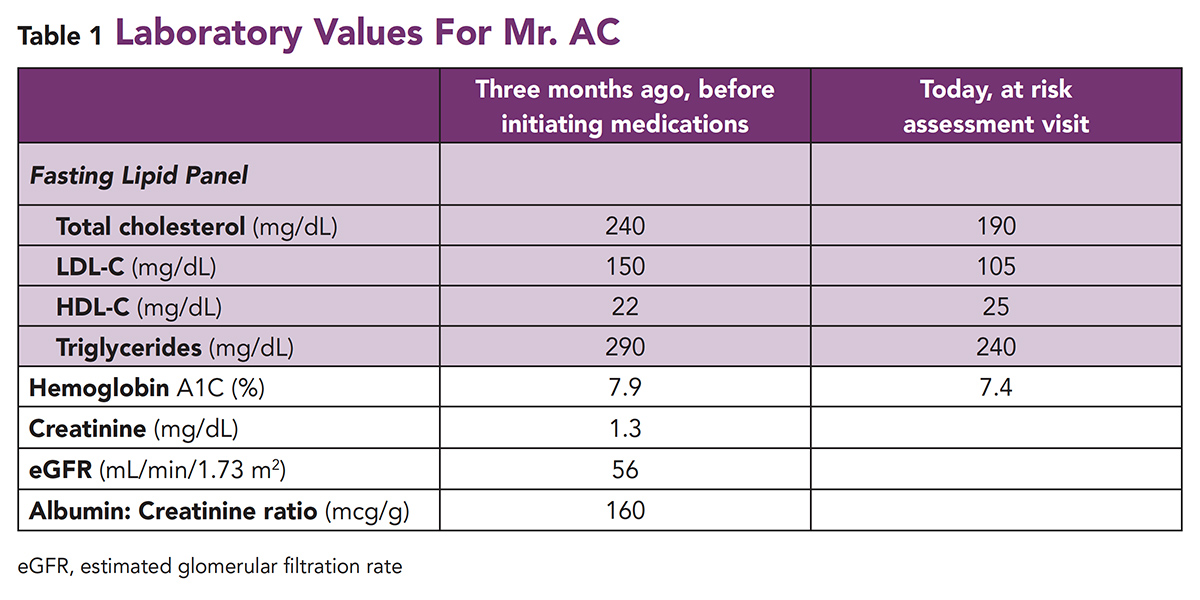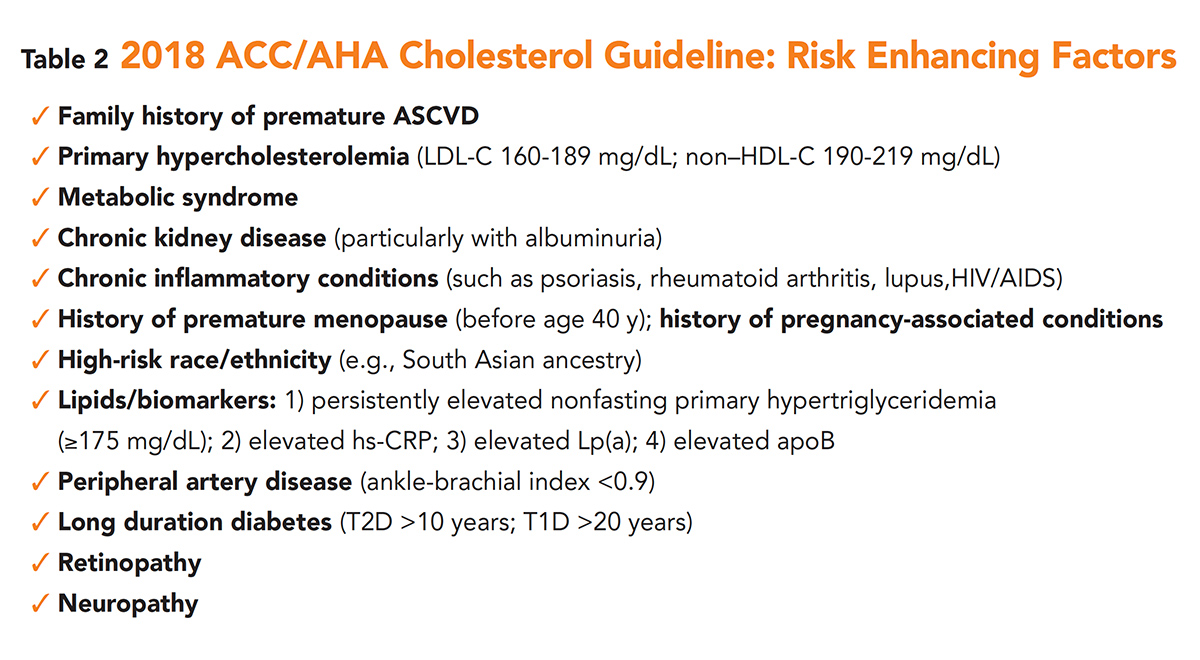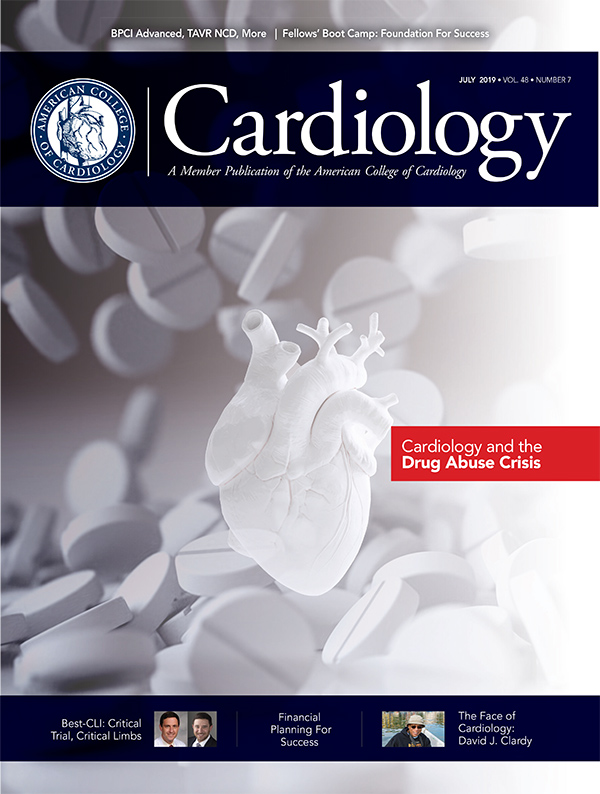Prevention | Comprehensive Cardiovascular Risk Reduction in South Asian Man With Diabetes

Mr. AC, a 54-year-old of South Asian descent, presents to your clinic for evaluation of his risk for atherosclerotic cardiovascular disease (ASCVD). He saw his primary care physician (PCP) for the first time in 30 years after his brother, a smoker with type 2 diabetes (T2D), recently suffered a myocardial infarction at the age of 53.
At his PCP visit, Mr. AC stated he felt well and denied any chronic medical conditions. In the subsequent three months, he was diagnosed with hypertension, hyperlipidemia and T2D.
His PCP started him on lisinopril 10 mg daily, hydrochlorothiazide 25 mg daily, rosuvastatin 10 mg daily and metformin 1,000 mg twice daily. He also improved lifestyle factors by initiating a walking program (30 minutes daily) and cutting sodas from his diet.
Despite these improvements, he admits to an overall sedentary lifestyle. He works as a computer programmer and sits much of the day. He plans to join a gym but has yet to do so. Additionally, he still occasionally eats fast food.
Nonetheless, he's adamant that he wants to do "whatever it takes to avoid a heart attack." He saw a TV commercial advertising a PCSK9 inhibitor and expressed a desire to start one. At this point, his PCP referred the patient to your practice for further evaluation and management. Table 1 lists his lab values.
ASCVD Risk Assessment
Assessment of ASCVD risk is the foundation of primary prevention. Mr. AC's 10-year risk of heart disease or stroke is 19.2 percent, based on today's estimate using the pooled cohort equation (PCE). This places him in the intermediate-risk category (7.5 percent to <20 percent). Before starting treatment three months ago, his risk was 30 percent.
However, he has multiple risk-enhancing factors not accounted for by the PCE, including high-risk ancestry (South Asian), chronic kidney disease with albuminuria, metabolic syndrome, elevated lipid biomarkers (persistently elevated triglycerides) and a family history of premature ASCVD.
Indeed, this burden of risk-enhancing factors is an alert that Mr. AC's actual risk is much higher than that predicted by the PCE alone.
A list of risk-enhancing features, including those specific to diabetics, is included in the 2018 ACC/AHA Cholesterol Guideline (Table 2).1 This information should be shared with patients to help inform the clinician-patient discussion regarding next steps for cardiovascular risk reduction.
Lifestyle Management

Lifestyle intervention is the cornerstone of ASCVD risk reduction. There are several critical steps Mr. AC must take to reduce his risk. A tailored nutrition plan focusing on a heart-healthy dietary pattern is an important step to improve glycemic control, weight loss and overall cardiovascular risk.
A diet enriched in vegetables, fruits, whole grains, legumes, healthy protein sources and vegetable oils is recommended. Foods that should be limited include processed foods, refined sugar (such as sugar sweetened beverages) and red meats.
Mr. AC also must increase his physical activity. The guidelines recommend engaging in 150 minutes of moderate-intensity physical activity or 75 minutes of vigorous-intensity physical activity per week.
This recommendation translates to regular aerobic physical activity at least five times per week, lasting on average 30 minutes per session. Beyond a formal exercise program, he should strive to reduce his sedentary behavior.
Pharmacologic Management
Lipids

Even with the lifestyle modifications, initiating statin treatment should be considered for Mr. AC. In fact, all adults with T2D who are 40 to 75 years old – regardless of their estimated 10-year ASCVD risk – warrant at least a moderate-intensity statin.
Although he's in the intermediate-risk category, based on the PCE, the presence of multiple risk-enhancing factors and his age favors the use of a high-intensity statin with a goal to reduce LDL-C by >50 percent. Therefore, the next step for Mr. AC is to uptitrate his rosuvastatin to the maximally tolerated dose.
An important addition to the 2018 Cholesterol Guideline is the recommendation to use nonstatin therapies if a 50 percent LDL-C reduction is not achieved with high-intensity statin therapy.
Ezetimibe is the preferred initial nonstatin given the reduction in cardiovascular events seen in the IMPROVE-IT and SHARP studies.2,3 The addition of ezetimibe 10 mg/d to moderate-intensity statin therapy can achieve the same percent LDL-C lowering as that achieved with high-intensity statin therapy.
Notably, Mr. AC does not qualify for a PCSK9 inhibitor now. He does not meet the criteria of high-risk ASCVD or a baseline LDL-C >190 mg/dL. If, however, he does not achieve a 50 percent reduction in LDL-C on a combination of the highest tolerated statin dose plus ezetimibe, then consideration of a PCSK9 inhibitor may be warranted.
Bile acid sequestrants (expected LDL-C lowering of 15 to 30 percent) are another alternative that can be considered if he experiences significant side effects with these therapies or if additional therapy is warranted.
An often neglected but important finding on his lipid panel is moderate hypertriglyceridemia. In adults 40 to 75 years old with moderate (175 to 499 mg/dL) or severe hypertriglyceridemia (≥500 mg/dL) and elevated ASCVD risk, a persistently elevated triglyceride level despite lifestyle modification favors initiating or intensifying statin therapy. This is true for Mr. AC.
A further opportunity for risk reduction for patients like Mr. AC is adding icosapent ethyl. A 30 percent reduction in total ischemic events was found in patients in the REDUCE-IT trial randomized to icosapent ethyl.4 The trial included 8,179 patients with elevated triglycerides and established ASCVD and/or diabetes (about 30 percent of the cohort had diabetes).
Further Considerations
Novel Diabetes Agents
Metformin is first-line therapy for treatment of T2D. Mr. AC was started on an appropriate dose of metformin. However, addition of a glucagon-like peptide-1 receptor agonist (GLP-1 RA) or sodium glucose co-transporter-2 inhibitor (SGLT2-i) may be considered for him as well.
Although he does not have established ASCVD, he has a significant number of risk factors that place him at high risk for a cardiovascular event.
An SGLT2-i may provide additional benefit given his albuminuria, based on the results of the CREDENCE trial, which demonstrated a benefit in both cardiovascular and renal outcomes in patients with chronic kidney disease and albuminuria.5 A GLP-1 RA may be considered due to his obesity, given the substantial weight reduction seen with this class of drugs.
Aspirin
The use of aspirin in primary prevention has been de-emphasized in the 2019 ACC/AHA Guideline on the Primary Prevention of Cardiovascular Disease.6 The ASCEND trial demonstrated a reduction in vascular events (rate ratio, 0.88; 95 percent confidence interval [CI], 0.79-0.97; p=0.01), but an increase in major bleeding events (rate ratio, 1.29; 95 percent CI, 1.09-1.52; p=0.003) in patients with T2D treated with aspirin.7
At this time, given the available data, there's no compelling reason to initiate aspirin in Mr. AC.
A coronary artery calcium (CAC) score may be useful as a decision tool. If he underwent CAC testing and was found to have a calcium score >100, it would be reasonable to start aspirin therapy, if he does not have an elevated bleeding risk.8
More Screening

Mr. AC should be screened for sleep apnea given his obesity and hypertension. He would also benefit from screening for environmental psychosocial stressors, such as depression, that not only independently elevate his cardiovascular risk but also may disrupt his ability to manage his other chronic medical conditions. Routine screening for depression, if not already completed by the PCP, can be accomplished by using the Patient Health Questionnaire-2 (PHQ-2).
The two questions in the PHQ-2 evaluate for 1) loss of interest in participating in activities, and 2) feelings of depression or hopelessness in the the previous two weeks. If the answer to either question is positive, further screening with the Patient Health Questionnaire-9 and informing the PCP regarding the findings is warranted. If a patient is an imminent suicide risk, he or she will require emergent psychiatric assessment.
Conclusion
Mr. AC underwent comprehensive evaluation and was found to have several risk factors, including T2D, that contribute to elevated ASCVD risk. Following your recommendations, he's made a commitment to make lifestyle changes.
His treatment regimen now includes an increase in his rosuvastatin dose to 40 mg daily, and he's started empagliflozin 10 mg daily given his albuminuria and a prescription for eicosapentaenoic acid fish oil.
He will continue his metformin (1,000 mg twice daily) and lisinopril (100 mg daily). Given lifestyle modifications and refinement in his medical therapy, his risk of suffering a heart attack like his brother has likely been significantly attenuated.
References
- Grundy SM, Stone NJ, Bailey AL, et al. 2018 AHA/ACC/ AACVPR/AAPA/ ABC/ACPM/ ADA/AGS/ APhA/ASPC/ NLA/PCNA guideline on the management of blood cholesterol. J Am Coll Cardiol 2018;Nov 8:[Epub ahead of print].
- Cannon CP, Blazing MA, Giugliano RP, et al. Ezetimibe Added to Statin Therapy after Acute Coronary Syndromes. N Engl J Med 2015;372:2387-97.
- Baigent C, Landray MJ, Reith C, et al. The effects of lowering LDL cholesterol with simvastatin plus ezetimibe in patients with chronic kidney disease (Study of Heart and Renal Protection): a randomised placebo-controlled trial. Lancet 2011;377:2181-92.
- Bhatt DL, Steg PG, Miller M, et al. Cardiovascular risk reduction with icosapent ethyl for hypertriglyceridemia. N Eng J Med 2019;380:11-22.
- Perkovic V, Jardine MJ, Neal B, et al. Canagliflozin and Renal Outcomes in Type 2 Diabetes and Nephropathy. N Engl J Med 2019;380:2295-2306.
- Arnett DK, Blumenthal RS, Albert MA, et al. 2019 ACC/AHA Guideline on the Primary Prevention of Cardiovascular Disease. J Am Coll Cardiol 2019; March 17:[Epub ahead of print].
- ASCEND Study Collaborative Group, Bowman L, Mafham M, Wallendzus K, et al. Effects of Aspirin for Primary Prevention in Persons with Diabetes Mellitus. N Engl J Med 2018;379:1529-39.
- Miedema MD, Duprez DA, Misialek JR, et al. Use of coronary artery calcium testing to guide aspirin utilization for primary prevention: estimates from the multi-ethnic study of atherosclerosis. Circ Cardiovasc Qual Outcomes 2014;7:453-60.
Clinical Topics: Cardiovascular Care Team, Diabetes and Cardiometabolic Disease, Dyslipidemia, Prevention, Hypertriglyceridemia, Lipid Metabolism, Nonstatins, Novel Agents, Statins, Exercise, Hypertension, Smoking
Keywords: ACC Publications, Cardiology Magazine, Albuminuria, Aspirin, Atherosclerosis, Bile Acids and Salts, Cardiovascular Diseases, Cohort Studies, Diabetes Mellitus, Type 2, Eicosapentaenoic Acid, Exercise Therapy, Heart Diseases, Hydrochlorothiazide, Hydroxymethylglutaryl-CoA Reductase Inhibitors, Hyperlipidemias, Hypertriglyceridemia, Hypertension, Lisinopril, Maximum Tolerated Dose, Metabolic Syndrome, Myocardial Infarction, Metformin, Physicians, Primary Care, Primary Prevention, Renal Insufficiency, Chronic, Risk Assessment, Risk Factors, Risk Reduction Behavior, Sedentary Behavior, Smoking, Smoking, Stroke, Triglycerides, Weight Loss
< Back to Listings






